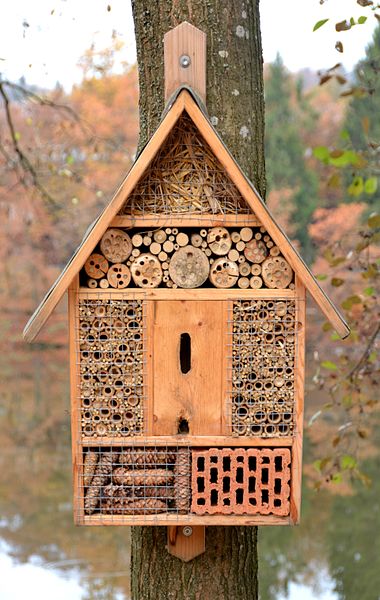Spring is here and gardens are a buzz! Insects play an important role in the environment as pollinators and nutrient recyclers. While it is easy to get carried away with the huge role that introduced European Honeybees (Apis mellifera) play in pollinating crops, there are many more species of native solitary bees (harmless and non-aggressive) that play a very active role in pollinating flowers. Not to mention the ants, butterflies, beetles and other invertebrates that are responsible for pollination. Attracting these critters not only increases biodiversity in your yard, but they will help to keep unwanted insects away.
When the rain comes and you feel the need for a vacation, you might book a hotel to stay in or organise accommodation on Airbnb. But what about the insects? Where do they go when it gets cold and wet? Many insects hunker down when it’s raining and lay eggs in safe, dry places. But many town yards are kept tidy and the lack of debris can mean that there are fewer places for insects to take refuge and lay eggs. An insect hotel can be the key to giving the native insects a helping hand. What about an Air Bee n Bee?!
While spring is here and you’re seeing insects active in your yard, use the warm weather to build an insect hotel ready for the next rains. Insects will use the hollows created to lay eggs, which will hatch in the next round of warm weather. It’s best to place the insect hotel in a dry place with protection from cold winds (a sheltered spot under the house, in front of a window). Ideally, the insect hotel opening of the hotel should be facing north or north-east with exposure to the sun, as it’s unlikely to be successful if placed in the shade. Finally, it should be firmly fixed so that it doesn’t sway in the wind.
You can use smooth (splinter-free), cylindrical spaces from a variety of materials, ranging in size from 3mm holes to 13mm holes (most commonly used around 5-6.5mm) and depths of 70mm to 150mm (according to Tim Heard, author of The Australian Native Bee Book, available at Red Kangaroo Books). A variety of sizes and shapes will cater to different insects and scattering a couple of small insect hotels around the property will increase your chances of providing for competing insects.
Materials used can include bamboo segments, holes drilled into solid untreated wood cubes, hose, paper straws, seed pods or rolls of cardboard. A length of polypipe filled with clay can attract insects that would normally burrow in the ground, which includes over half of Australia’s bee species. The items can be stacked in an empty wooden box or tied together with a sloping roof to keep the hotel dry. Ensure that it has a backing so that it doesn’t turn into an open-ended wind tunnel. You can place a strip of chicken mesh over the front of the insect hotel if you wish to protect the larvae from birds without deterring the hotel guests. The insect hotel can be decorated with old metal for a rustic style or shiny items for that bit of extra ‘bling’. Use anything that you find (recycled items are free or very cheap!), there is no standard design and you are only limited by your imagination!
This time next year when the hotel apartments are emptying out, you can report sightings of your insect guests on Bowerbird and have them identified. Once the insect hotel is vacant again, maintain it by cleaning out any used cells and replace parts if fungus moulds develop. Check out the Valley Bees factsheet for more information on creating an insect hotel.
If you don’t have the capacity to make in insect hotel for your town block, you can provide natural homes for insects by retaining some leaf litter, planting local native trees that produce peeling bark and leave dead branches in situ.
Categories:
Biodiversity, Gardening, Invertebrates, Native Fauna, Nest
